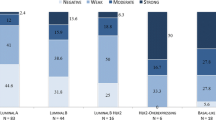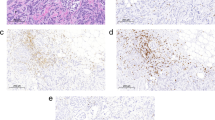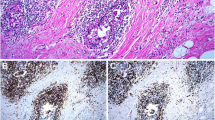Abstract
Medullary carcinoma (MC) of the breast is characterized by large anaplastic cells and infiltration by benign lymphocytes. Patients with this pattern of breast carcinoma are considered to have a better prognosis than those with other histological subtypes. We reviewed cases of primary breast carcinoma that were surgically resected between 1990 and 2004. Of these, 13 cases of medullary carcinoma of the breast with lymphocyte infiltration were reported. Tests for CD3, CD4, CD8, CD20, CD56, TIA-1, and granzyme B were performed on paraffin sections. We found that the MC contained very few NK cells, as assessed by their reactivity with the CD56 antibodies. However, MC had a significantly greater percentage of CD3, CD8, TIA-1, and granzyme B lymphocytes infiltrating the stroma of the tumor. Furthermore, more CD8-positive than CD4-positive T-cell lymphocytes were present within the tumor cell nests in MC, as opposed to the proportion in usual ductal carcinoma. The infiltrating cytotoxic/suppressor T cells in MC represent host resistance against cancer, and the high grading of the T-cell infiltration could explain, in part, a key mechanism controlling the good prognosis for this type of tumor and solve the pathological paradox of MC.






Similar content being viewed by others
References
Arlen M, Flores L, Elguezbal A, Levowitz BS (1976) Nodal response in medullary carcinoma of the breast. Am J Surg 131:263–266
Ben-Ezra J, Sheibani K (1987) Antigenic phenotype of the lymphocytic component of medullary carcinoma of the breast. Cancer 59:2037–2041
Bhan AK, DesMarais CL (1983) Immunohistologic characterization of major histocompatibility antigens and inflammatory cellular infiltrate in human breast cancer. J Natl Cancer Inst 71:507–516
Bloom HJG, Richardson WW, Filed JR (1970) Host resistance and survival in carcinoma of the breast a study of 104 cases of medullary carcinoma is a series of 1,411 cases of breast cancer followed for 20 years. BMJ 3:181–187
Gaffey MJ, Frierson HF, Mills SE, Boyd JC, Zarbo RI, Simpson JF, Gross LK, Weiss LM (1993) Medullary carcinoma of the breast. Identification of lymphocyte subpopulations and their significance. Mod Pathol 6:721–728
Gaudin C, Dietrich PY, Robache S, Guillard M, Escudier B, Lacombe MJ, Kumar A, Triebel F, Caignard A (1995) In vivo local expansion of clonal T cell subpopulations in renal cell carcinoma. Cancer Res 55:685–690
Georgiannos SN, Renaut A, Goode AW, Sheaff M (2003) The immunophenotype and activation status of the lymphocytic infiltrate in human breast cancers, the role of the major histocompatibility complex in cell-mediated immune mechanisms, and their association with prognostic indicators. Surgery 134:827–834
Hudson JM, Castilleja A, Murray JL, Honda T, Kudelka A, Singletary E, Wharton JT, Ioannides CG (1998) Growth and antigen recognition of tumor-infiltrating lymphocytes from human breast cancer. J Interferon Cytokine Res 18:529–536
Marrogi AJ, Munshi A, Merogi AJ, Ohadike Y, El-Habashi A, Marrogi OL, Freeman SM (1997) Study of tumor infiltrating lymphocytes and transforming growth factor-beta as prognostic factors in breast carcinoma. Int J Cancer 74:492–501
Moore OS, Foote FW (1949) The relatively favorable prognosis of medullary carcinomas of the breast. Cancer 2:635–642
O’Mahony AM, O’Sullivan GC, O’Connell J, Cotter TG, Collins JK (1993) An immune suppressive factor derived from esophageal squamous carcinoma induces apoptosis in normal and transformed cells of lymphoid lineage. J Immunol 151:4847–4856
Rapin V, Contesso G, Mouriesse H, Bertin F, Lacombe MJ, Piekarski JD, Travagli JP, Gadenne C, Friedman S (1988) Medullary breast carcinoma: a reevaluation of 95 cases of breast cancer with inflammatory stroma. Cancer 19:2503–2510
Reinfuss M, Stelmach A, Mitus J, Rys J, Duda K (1995) Typical medullary carcinoma of the breast: a clinical and pathological analysis of 52 cases. J Surg Oncol 60:89–94
Restifo NP, Marincola FM, Kawakami Y, Taubenberger J, Yannelli JR, Rosenberg SA (1996) Loss of functional beta 2-microglobulin in metastatic melanomas from five patients receiving immunotherapy. J Natl Cancer Inst 88:100–108
Ridolfi RL, Rosen PP, Port A, Kinne D, Mike V (1977) Medullary carcinoma of the breast: a clinicopathologic study with 10-year follow up. Cancer 40:1365–1385
Shimokawara I, Imamura M, Yamakawa N, Ishii Y, Kikuchi K (1982) Identification of lymphocyte subpopulations in human breast cancer tissue and its significance: an immunoperoxidase study with anti-human T-and B-cell sera. Cancer 49:1456–1464
Tanaka H, Hori M, Ohki T (1992) High endothelial venule and immunocomponent cells in typical medullary carcinoma of the breast. Virchows Arch 420:253–261
Tamiolakis D, Simopoulos C, Cheva A, Lambropoulou M, Kotini A, Jivannakis T, Papadopoulos N (2002) Immunophenotypic profile of tumor infiltrating lymphocytes in medullary carcinoma of the breast. Eur J Gynaec Oncol 23:433–436
Toso JF, Oei C, Oshidari F, Tartaglia J, Paoletti E, Lyerly HK, Talib S, Weinhold KJ (1996) MAGE-1-specific precursor cytotoxic T-lymphocytes present among tumor-infiltrating lymphocytes from a patient with breast cancer: characterization and antigen-specific activation. Cancer Res 56:16–20
Wargotz ES, Silverberg SG (1988) Medullary carcinoma of the breast: a clinicopathologic study with appraisal of current diagnostic criteria. Hum Pathol 19:1340–1346
Yakirevich E, Izhak OB, Rennert G, Kovacs ZG, Resnick MB (1999) Cytotoxic phenotype of tumor infiltrating lymphocytes in medullary carcinoma of the breast. Mod Pathol 12:1050–1056
Yazawa T, Kamma H, Ogata T (1993) Frequent expression of HLA-DR antigen in medullary carcinoma of the breast. A possible reason for its prominent lymphocytic infiltration and favorable prognosis. Appl Immunohistochem 1:289–296
Acknowledgements
We sincerely thank A. Adachi, M.D., I. Miura, M.D., Y. Toyosumi, M.D., S. Momose, M.D., T. Ougida, C.T., M. Abe, C.T., T. Saito, C.T., K. Kiuchi, C.T., K. Ohsawa, C.T., K. Matsuno, C.T., K. Hanami, C.T., Y. Ohno, C.T. and T. Masuda, C.T. for their technical assistance and advice.
Author information
Authors and Affiliations
Corresponding author
Rights and permissions
About this article
Cite this article
Kuroda, H., Tamaru, Ji., Sakamoto, G. et al. Immunophenotype of lymphocytic infiltration in medullary carcinoma of the breast. Virchows Arch 446, 10–14 (2005). https://doi.org/10.1007/s00428-004-1143-9
Received:
Accepted:
Published:
Issue Date:
DOI: https://doi.org/10.1007/s00428-004-1143-9




